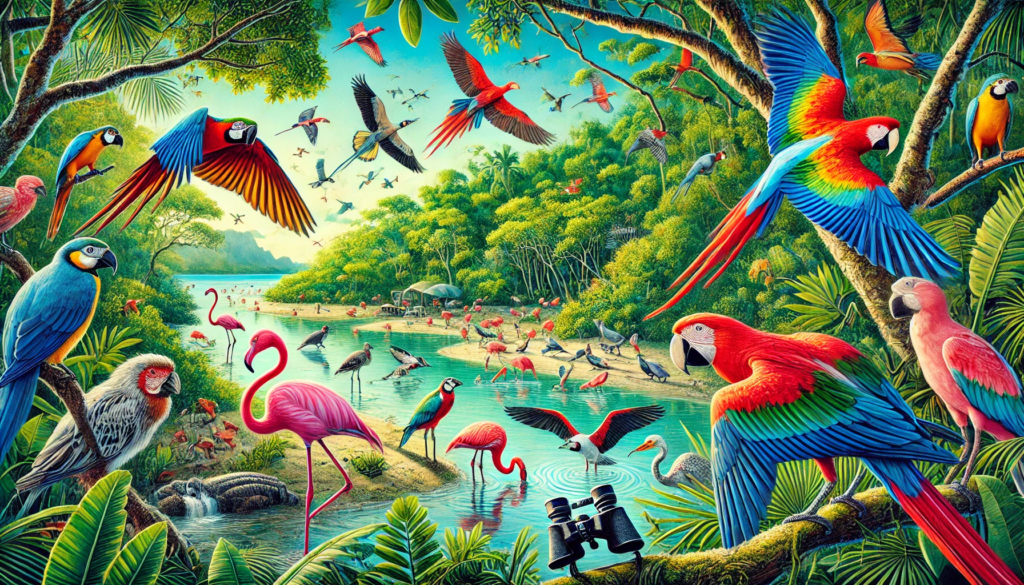The Caribbean is renowned not only for its vibrant marine life and tropical landscapes but also for its remarkable bird species. From the colorful parrots that brighten the island forests to the elegant flamingos that grace the wetlands, the avian diversity in the Caribbean offers a unique opportunity for bird enthusiasts and conservationists alike. With a wide variety of native, endemic, and migratory species, birdwatching in the Caribbean has become an increasingly popular activity, offering a window into the rich biodiversity of the region.
Birdwatching in the Caribbean isn’t just about observing exotic birds; it also plays a vital role in conservation efforts, as many species face significant threats due to habitat loss and climate change. This article explores some of the most notable bird species in the Caribbean, including parrots, flamingos, and migratory birds, while highlighting the importance of birdwatching as both a recreational activity and a tool for conservation.
Notable Bird Species in the Caribbean
The Caribbean is home to over 700 bird species, with around 150 species being endemic to the region. This rich diversity is due to the variety of habitats found across the islands, from rainforests and mangroves to coastal lagoons and highland forests. Many bird species in the Caribbean have adapted to these unique environments, creating a region that is a hotspot for avian biodiversity.
Parrots: Vibrant Symbols of the Caribbean
Parrots are among the most iconic bird species in the Caribbean. Known for their brilliant plumage and playful personalities, parrots inhabit several Caribbean islands and are often closely associated with the region’s identity. However, many Caribbean parrots are endangered due to habitat destruction and illegal pet trade, making conservation efforts crucial to their survival.
The Puerto Rican Parrot
The Puerto Rican parrot (Amazona vittata), or “Iguaca,” is one of the most endangered birds in the world and the only native parrot species of Puerto Rico. Once abundant throughout the island, the population declined drastically in the 20th century due to deforestation, hurricanes, and the introduction of non-native species. By the 1970s, fewer than 50 individuals remained in the wild.
Today, thanks to intensive conservation efforts, including breeding programs and habitat restoration, the Puerto Rican parrot population is slowly recovering. These efforts have expanded to include reintroducing parrots into the El Yunque National Forest and other protected areas. Birdwatchers visiting Puerto Rico may have the rare opportunity to see these vibrant green parrots in their natural habitat as conservation initiatives continue to safeguard their future.
The Saint Lucia Parrot
Another notable parrot species is the Saint Lucia parrot (Amazona versicolor), known for its striking green, blue, and red feathers. As the national bird of Saint Lucia, this parrot has become a symbol of pride and conservation on the island. Like many of its relatives, the Saint Lucia parrot was once on the brink of extinction, but thanks to a dedicated conservation program led by the government and local organizations, the species has made a remarkable recovery.
Birdwatchers on the island can visit the Millet Bird Sanctuary or explore the rainforests of the central mountains to catch a glimpse of these beautiful birds. The conservation success of the Saint Lucia parrot demonstrates the importance of protecting critical habitats and promoting awareness among local communities about the value of their native wildlife.
Flamingos: Graceful Inhabitants of Coastal Wetlands
Flamingos are another well-known bird species in the Caribbean, admired for their elegance and striking pink coloration. These large, wading birds are typically found in coastal lagoons, salt flats, and mangrove swamps, where they feed on small crustaceans, algae, and other microorganisms that contribute to their distinctive pink hue.
The American Flamingo
The American flamingo (Phoenicopterus ruber) is the most common flamingo species found in the Caribbean. These birds are social creatures, often seen in large flocks wading through the shallow waters of coastal wetlands. The pink flamingos of the Bahamas, Cuba, and Bonaire are particularly famous, drawing birdwatchers and nature enthusiasts from around the world.
One of the best places to observe flamingos in the Caribbean is the Inagua National Park in the Bahamas, home to the largest breeding colony of American flamingos in the region. Birdwatchers can witness tens of thousands of flamingos nesting and feeding in this protected area, which also supports a variety of other bird species.
Migratory Birds: Seasonal Visitors to the Caribbean
In addition to its resident bird species, the Caribbean plays a critical role in the migration patterns of many birds. Each year, millions of migratory birds from North and South America pass through the Caribbean, using the islands as stopover points to rest and refuel during their long journeys. These migratory birds add to the region’s avian diversity and make the Caribbean a crucial area for bird conservation.
Warblers and Shorebirds
Migratory warblers are some of the most commonly seen birds during the fall and spring migration seasons. Species like the Black-and-white warbler (Mniotilta varia), the Northern parula (Setophaga americana), and the American redstart (Setophaga ruticilla) can be spotted flitting through the forests and gardens of Caribbean islands as they make their way to or from their wintering grounds in Central and South America.
Shorebirds, such as sandpipers, plovers, and oystercatchers, also frequent the Caribbean’s beaches and wetlands. These migratory birds rely on the region’s coastal habitats to forage for food during their stopovers. Protecting these habitats is essential to ensuring the survival of migratory bird populations, which face threats from habitat loss, climate change, and hunting along their migration routes.
Endemic Birds: Unique Species of the Caribbean
The Caribbean is home to a high number of endemic bird species, meaning they are found nowhere else in the world. This endemism is largely due to the islands’ geographic isolation, which has allowed species to evolve independently over time. Some of the most striking endemic birds in the Caribbean include the Cuban trogon, the Jamaica tody, and the Hispaniolan woodpecker.
The Cuban Trogon
The Cuban trogon (Priotelus temnurus), known locally as the “tocororo,” is the national bird of Cuba and one of the most colorful birds in the Caribbean. Its bright red, blue, and white feathers reflect the colors of the Cuban flag, making it a symbol of national pride. The tocororo can be found in forests and woodlands throughout Cuba, where it feeds on insects, fruit, and small reptiles.
The Jamaica Tody
The Jamaica tody (Todus todus) is a tiny, brightly colored bird endemic to Jamaica. Despite its small size, the Jamaica tody is a favorite among birdwatchers due to its vivid green and red plumage and its distinctive behavior of perching on branches to hunt for insects. These birds are often seen in pairs or small groups, darting through the understory of Jamaica’s forests.
Birdwatching in the Caribbean: A Growing Eco-Tourism Activity
Birdwatching, or birding, has become an increasingly popular eco-tourism activity in the Caribbean, attracting both amateur and professional ornithologists to the islands. The diversity of bird species, combined with the region’s stunning natural landscapes, makes the Caribbean an ideal destination for birdwatchers. From dense rainforests and mangrove swamps to mountain ranges and coastal wetlands, the region offers a wide variety of habitats that support a broad range of avian life.
Top Birdwatching Destinations in the Caribbean
Several Caribbean islands are renowned for their birdwatching opportunities, offering a chance to see both endemic species and migratory birds in their natural habitats. Some of the top birdwatching destinations in the Caribbean include:
- Trinidad and Tobago: Known as one of the best birdwatching spots in the Caribbean, Trinidad and Tobago is home to over 450 bird species. The Asa Wright Nature Centre, located in the rainforest-covered Northern Range of Trinidad, is a popular destination for birdwatchers, offering guided tours to see species like the oilbird, bellbird, and toucans. In Tobago, the Main Ridge Forest Reserve is a haven for birdwatching, with species like the Blue-backed manakin and the White-tailed sabrewing hummingbird.
- Jamaica: Jamaica boasts over 300 bird species, including 28 endemics, making it a prime location for birdwatchers. The Blue and John Crow Mountains National Park offers birdwatchers a chance to see the Jamaica blackbird, the streamertail hummingbird, and the rare Jamaican owl.
- Bahamas: The Bahamas are home to many coastal and migratory bird species, with the Inagua National Park being one of the best places to observe flamingos, herons, and the endangered Bahama parrot.
- Cuba: Cuba is an exceptional birdwatching destination with over 360 bird species, including 26 endemics. The Zapata Swamp, located in the southern part of the island, is a birdwatcher’s paradise, known for species like the Cuban trogon, the bee hummingbird (the smallest bird in the world), and the Zapata rail.
Birdwatching as a Conservation Tool
Birdwatching not only provides an enriching outdoor experience but also serves as a valuable tool for conservation. By promoting awareness of bird species and their habitats, birdwatching encourages the protection of natural environments and supports eco-tourism initiatives that benefit local communities. Birdwatchers, through citizen science programs, often contribute to bird monitoring efforts by recording sightings and helping to track bird populations and migration patterns.
Eco-tourism initiatives that focus on birdwatching are essential for conserving critical habitats, especially in regions where birds face significant threats from deforestation, wetland drainage, and climate change. Birdwatching tours often emphasize responsible practices that minimize human impact on wildlife, such as maintaining a respectful distance from birds and avoiding disturbance of nesting sites.
Conclusion
The Caribbean’s bird species, from the colorful parrots and graceful flamingos to the diverse migratory birds, are a testament to the region’s rich biodiversity. Birdwatching in the Caribbean offers a unique opportunity to observe these remarkable species in their natural habitats while supporting conservation efforts that protect both birds and their ecosystems.
As more people embrace birdwatching as a form of eco-tourism, the Caribbean continues to be a top destination for those seeking to connect with nature and witness the beauty of the avian world. Through responsible birdwatching practices and conservation initiatives, we can ensure that the vibrant birdlife of the Caribbean thrives for generations to come.
FAQ
What are the most common bird species in the Caribbean?
Some of the most common bird species in the Caribbean include parrots, flamingos, warblers, and shorebirds. Endemic species such as the Cuban trogon and the Jamaica tody are also notable in the region.
Where can I go birdwatching in the Caribbean?
Top birdwatching destinations in the Caribbean include Trinidad and Tobago’s Asa Wright Nature Centre, Jamaica’s Blue and John Crow Mountains National Park, and Cuba’s Zapata Swamp. The Bahamas are also known for flamingo sightings.
Why is birdwatching important for conservation?
Birdwatching promotes awareness of bird species and their habitats, encouraging conservation efforts. Eco-tourism initiatives focused on birdwatching help protect natural environments and support local economies.
Are there endangered bird species in the Caribbean?
Yes, several Caribbean bird species are endangered, including the Puerto Rican parrot, the Bahama parrot, and the Saint Lucia parrot. Conservation efforts are underway to protect these species.
What is the best time of year for birdwatching in the Caribbean?
The best time for birdwatching in the Caribbean is during the migratory seasons in spring and fall when many migratory species pass through the region. However, endemic and resident species can be observed year-round.
How do migratory birds contribute to the biodiversity of the Caribbean?
Migratory birds use the Caribbean as a stopover during their long journeys between North and South America. They contribute to the region’s biodiversity by adding seasonal species to the local bird populations and relying on Caribbean habitats for rest and feeding.

